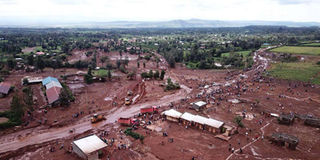Solai dam tragedy: Search for justice drags on in court

The aftermath of the Solai dam tragedy. Four years after the tragedy, in which 48 people died, justice remains elusive for survivors and victims as they struggle to recover.
Four years after the Solai dam tragedy, in which 48 people died, justice remains elusive for survivors and victims as they struggle to recover.
A case against the proprietors of the dam is still dragging on in court since 2018.
Although more than 20 witnesses have testified in the case, little progress has been made in the case before a Naivasha court, with adjournments being the order of the day.
The court has accused the Office of the Director of Public Prosecution (ODPP) of delaying the matter by failing to appear during previous hearings.
However, on Friday, the court heard that prior to the tragedy, government agencies had declared the dam stable after a series of inspections.
In what could point to state negligence, Chief Inspector Joseah Mariti, who was involved in the investigations, told the court that tests done months before the tragedy had indicated that the dam did not pose any threat.
“I collected evidence from the victims and various state agencies including the Water Resource Authority, National Environment Management Authority and the conservation authority concerning the dam, soon after the incident. All indicated the government agencies had declared the dam safe,”the officer told Naivasha Chief Magistrate Nathan Lutta.
A multi-agency report on the tragedy presented in court by then Rift Valley regional coordinator Chimwaga Mongo was rejected by the accused.
Senior Counsel Pravin Bowry, representing the first two accused, faulted the report saying that it was compiled by experts who were not in court. He accused the prosecution of trying to introduce new evidence through the backdoor.
Solai farm owner Perry Mansukh and eight others have been charged with 48 counts of manslaughter and failing to prepare an environmental impact assessment report. Also charged are the farm’s General Manager Vinoj Jaya Kumar, Nakuru County Water Director Johnson Kamau Njuguna, Water Resources Authority and National Environment Management Authority officers Luka Kipyegen, Winnie Muthoni, Jacinta Were, Tomkin Odo Odhiambo, Willie Omondi and Lynette Cheruiyot.
In February 2020, a Naivasha court acquitted the nine suspects charged with causing the death of 48 people. Chief Magistrate Kennedy Bidali cited a “lack of willingness and support” from the ODPP in prosecuting the case. He said that months after the case started, little progress had been made.
Retrial
However, the Director of Public Prosecutions Noordin Haji later successfully appealed against the acquittal, occasioning a retrial.
The private dam burst its banks on the night of May 8, washing away the surrounding villages of Energy, Nyakinyua, Endao, Milmet and Arutani.
Besides the deaths, the tragedy left at least 5,000 people homeless.
Four years after the tragedy, after the tragedy that shocked the country, exposed huge rocks, half-standing buildings and gullies dominate what was once a carpet of fertile soil on which locals practised farming.
The Kenya Red Cross and a local church constructed 37 permanent and semi-permanent houses for the survivors. The houses, built at a cost Sh40 million, were completed and handed over months after the tragedy.
Safaricom helped reconstruct the school, which was most affected by the tragedy and is also actively involved in the restoration process.
Kenya Power and other organisations have also intervened to restore water and electricity supply in the area.





